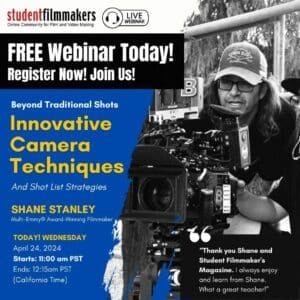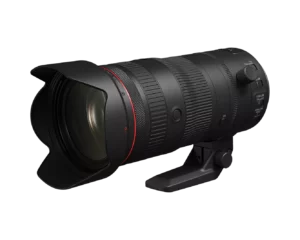Reference: StudentFilmmakers Magazine, 2015. February 2008. Seeing the Light: Working with a Combination of Filters and Internal Reflections: Remove Distracting ‘Infernal’ Reflections by Ira Tiffen. Pages 12 & 13.
Things are looking up. At least our camera is. Capturing the streetlamp overhead, we want to make it more prominent, so we bring two filter effects into play: a Tiffen 6-point 3mm Star and a Schneider Black Frost 2.
The Star effect flares out in fine points of light in typical star fashion. In addition, the Black Frost flares the light out in a soft glow in all directions. In combination, we get the result we want.
Except for one thing more – with the use of both filters, there suddenly appears an annoying ‘constellation’ of light on the post just below the streetlamp. Now, we know there’s no light there in the scene, but there it is in the image!
How does that happen?
To understand this phenomenon, (perhaps the source for some of the UFO images recorded through the years) we need to follow the light as it travels from the scene, through the two filters, and into the lens.
We know that light reflects when striking the front glass surface of the first filter. Out comes about 4% of the overall light back at us as reflection. Again, the same thing from the rear surface. About 4% of that light will reflect back through the filter, some of which will again reflect from the front surface and head back toward the second filter. Still following along? Good, because it gets tricky…
The light that made it through the first filter now has the second one to deal with. And the same thing happens there, too. About 4% of the light hitting the first surface of the second filter is reflected back at the first filter, and another 4% is reflected again from the second surface. Some of that light reflects back from the second filter and… I think you get the picture. There’s a whole lot of reflecting going on! The result is that light is cast into the lens from places in the image where there is no light, just the bounce of internal reflections.
Since this type of reflection happens inside the boundaries of glass in front of the lens, we call it internal reflection. Now, most of the time, this isn’t a concern. Sometimes, it may even be desirable. But sometimes it shows up and spoils the party, creating distracting ‘infernal’ reflections where we don’t want any. This usually occurs when there is a bright source of light in the scene against a dark background. Streetlamps, car headlights, and the like, especially around nighttime, are all potential culprits.
It happens that, if the lights and the internal reflections line up, they superimpose and you don’t see the additional reflections. Initially, mount your filters so that they are parallel to each other and to the image recording plane, and you have a good chance that this will be the case.
Sometimes, though, the focal length and the angle of view, the position of the lights or some other element causes unwanted internal reflections to appear as they do in our example. When this happens, the fix comes from looking at the situation from a new angle… literally.
Find a way to tilt the filter pair a few degrees from parallel to the image recording plane. Do this just enough, and you will see the internal reflections change their position in the image until they ‘slide’ right off the picture. What you are doing is changing the reflectance angle so that the offending light is reflected to a point outside the image area.
There are matte boxes that are made to facilitate this, in that they have filter slots that can be tilted by several degrees. If you don’t have access to such a one, then you can try other means, such as using gaffer tape to hold them on the lens at the requisite position.
Yet another benefit of the seeing the light from a new angle…
Photographs by the author.
In over 30 years of making optical filters, Ira Tiffen created the Pro-Mist, Soft/FX, Ultra Contrast, GlimmerGlass, and others, netting him both a Technical Achievement Award from the Academy of Motion Picture Arts and Sciences and a Prime-Time Emmy Award. Elected a Fellow of the SMPTE in 2002, he is also an Associate member of the ASC, and the author of the filter section of the American Cinematographer Manual.



